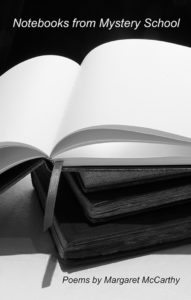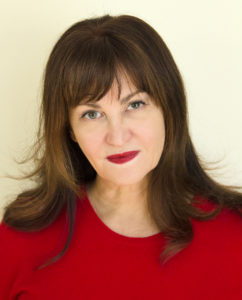Review by Hannah Cohen
A beautiful book centered upon the knowns and the unknowns of being human, Margaret McCarthy’s collection Notebooks from Mystery School reveals the mundane and sublime in our lives—from domestic arguments to art and even mythological figures. The nomination for the New Women’s New Voices Award is clearly deserved for McCarthy’s intricate and affecting words.
A talented artist on the page, stage and the wall, McCarthy includes intriguing black and white photographs, heightened forms of language for the theatre, and of course, her poetry in this work. She’s been in an artist-in-residence at the Virginia Center for the Creative Arts and The Hambridge Center for the Creative Arts & Sciences, while her poems have been published in The Pagan Muse: Poems of Ritual and Inspiration, Gargoyle Magazine, and California State Poetry Society Quarterly, among others.
Notebooks from Mystery School begins with “Approaching Samhain,” a poem with immediate textures and long vowel sounds such as “raw October air”, “rotting wood”, and “porch” (1). The speaker is recalling a childhood memory of “set[ting]out / to go looking for witches” (1) during what we know as Halloween season. However, a sense of not-quite death permeates the poem: “freshly emptied innards / clinging,” “light / drained from the day,” and the creeping of “the terrible hand of the unknown” (1-2). This poem prefaces most of the book’s concerns about the darker underneath, along with the mystery of female representation and identity.
The spiritual successor to the opening poem, “The Shadow Mother” is a narrative tale in four parts that feels perfectly plucked from a translated Greek tragedy. The poet’s use of line breaks and white space reminds one of printed plays and dramas, and is especially masterful in the first section:
I could have, I should have
gone straight down
into the icy depths; but I stood there on the shore, hesitating
waiting
and watching as she became thin, translucent as worn silk, (6)
With such deliberate pauses on the page, it only makes sense that conventional punctuation would break in the second section as seen with “she waited and waited / and waited some more / she shuffled from room to room / she pursed her lip” (7). The reader is absorbed into the physical and interior drama of the mother figure and her attachment to the ever-destructive house, that “stripped down place” (9). Consider the specific introduction and focus on “the princess daughter” in the third and fourth sections—a turn toward surreal fairy tale with the inclusion of wrecking balls and druids. With an ending haunting and yet poignant, we’re left with the understanding that the “heart’s architecture” is something that can be changed and rebuilt despite damage.
The heart of McCarthy is best revealed in “An Argument in the Kitchen”, a poem which serves as the emotional crux for the entire collection. The juxtaposition of a normal family dinner and conflicting politics create a tension that builds with every line: “Saddam is a madman— / I am 14 again, I don’t belong here…Across the table, across the gulf, / a chasm of blood” (13-14). The Gulf War as a metaphor for the rift between daughter and parents is unique and gut-wrenching, and we’re left reeling under “[t]he January stars…the night, cold / and endless” (15).
Other poems also delve into the bitter tension of adulthood and being a woman or girl; for example, “The Dolls” twists the image of the toy most girls grew up playing with into an empty commentary about childhood and leaves us with the heartbreaking couplet of “No mother ever loved her real daughter so. / No daughter ever loved her real mother so” (5). On the amusing side, there’s “Thirteen Ways of Looking at Cher”, a poem taking inspiration from Wallace Stevens’ catalogue. Thinking of the numerous metamorphoses the pop singer has been through the last several decades in relation to one’s own growth, this stanza in particular rings true:
I do not know which to prefer,
creation or transformation;
what I make in this world,
or the re-making of myself. (20)
Speaking of creation and art, “Photography” is an ekphrasis about the “process of casting / sight into silver” (24). A beautiful sentence with its slick “s”, hard/soft “c” and short vowel sounds, there’s no doubt that there’s importance placed on the auditory and visual appearance of words. This compact poem has a broken-off italicized stanza as if a soliloquy: “and still the shadow of that cloud escaped me, / that light” (24). Looking back on the previous and even final poems of this collection, darkness and light are constantly ebbing and flowing as words and themes. Thankfully, McCarthy steers from cliché and presents these opposites as cyclical and part of human nature.
Notebooks from Mystery School is enigmatic in its own mysticism and reverence for relationships, loss, and love. Though her work can sometimes border on esoteric or far-reaching, it’s important to know that these poems are meant to be read multiple times for new interpretations and outlooks on the self. Indeed, Margaret McCarthy and her poetry is “a waking vision of the possible” (23).
Notebooks from Mystery School
by Margaret McCarthy
Finishing Line Press, 2015, $12.49 [paper]
ISBN 9781622298532
31pp
Hannah Cohen lives in Virginia and is a MFA candidate at Queens University of Charlotte. She’s also a contributing editor for Platypus Press. Recent work has appeared or is forthcoming in Severine, Glass: A Journal of Poetry, Noble/Gas Qtrly, and elsewhere.


